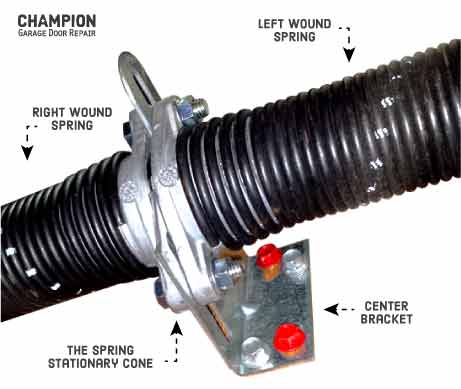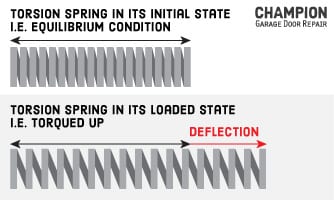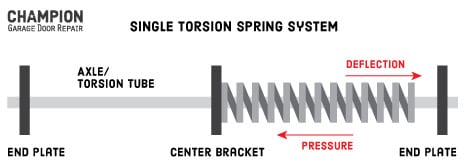While garage doors can function with a single spring, using two offers significant benefits. Let’s examine the disadvantages of having one spring and the advantages of having two springs.
1. Safety Hazard When the Spring Breaks
The purpose of the garage door spring is to generate mechanical energy, also known as torque, to counterbalance and support the weight of the door. When a spring breaks on a garage door with one spring, there is no mechanical energy available to support the door.

Consequently, the garage door becomes extremely heavy and difficult to operate safely. The increased weight overloads and strains the door sections, garage door opener, and other mechanisms, potentially causing damage and premature wear and tear.
2. Impact of a Broken Spring on Garage Door Cables
If a spring breaks on a garage door with two springs, the other spring usually maintains tension on the door cables, keeping them in place. However, in a garage door with just one spring, there’s no tension to keep the cables under tension when it breaks. As a result, the door cables become loose and could disengage from the pulleys and the door. This can lead to various issues, including misalignment, an off-track door, and difficulties in opening or closing the garage door. Additionally, it increases the risk of the cables becoming tangled or twisted, potentially causing the garage door to slam shut, damaging the system and resulting in additional complications.
3. Pressure in the Opposite Direction of Spring Deflection
In the case of a garage door with only one spring, there is no counterforce from the other side of the center bracket. Consequently, constant pressure is exerted on the torsion tube in the opposite direction of the spring’s deflection.


This pressure causes the torsion tube to shift from side to side, potentially leading to misalignment issues and unusual noise. It can also result in unexpected breakdowns, grinding of the shaft, and premature wear and tear of various moving parts of the garage door, including bearings, pulleys, cables, rollers, and hinges.
What Garage Doors Can Work with One Spring
Garage door torsion assemblies feature a torsion tube that serves as an axle, enabling the rotation of the pulleys. Consequently, a single torsion spring can work in conjunction with this axle to manage the counterbalance system. This is in contrast to garage doors with extension assemblies, which are required to have two or more extension springs, as each spring supporting one side of the door independently.
Advantages of Having More Than One Spring
Having more than one spring in a garage door system offers two main advantages:
Redundancy and Safety: In a multi-spring setup, if one spring were to fail or break, the remaining spring or springs may still be intact and able to provide some level of support to the door, preventing a sudden door collapse. Although the torque generated by the remaining springs may not be sufficient for proper and safe operation, this redundancy enhances safety by minimizing the risk of an uncontrolled door movement. It also enables you to force open the door in case your cars are inside.
Even Load Distribution: With two springs or more, the pressure on the torsion tube is distributed more evenly, allowing for smoother operation. This distribution reduces stress on the torsion assembly mechanisms and potentially extends their lifespan.
Can a Single Spring Setup Be Converted to a Double Spring?
It is possible to convert a single spring setup to a double spring setup in a garage door system. This process may require professional assistance from a trained technician. To convert a single spring setup to a double spring setup, the following steps are typically involved:
- Evaluation: Assess the current garage door to determine if it is suitable for a double spring setup. You should consider factors such as the door’s weight, size, and tracks radius.
- Spring Selection: Choose the appropriate springs based on the evaluation. The springs should produce the right torque output to ensure balanced operation.
- Installation: Remove the existing single spring and install two new springs, properly positioned and aligned. This may involve adjusting the spring tension and attaching them securely to the center bracket.
- Balancing: After installing the double spring setup, carefully balance the door by adjusting the tension on each spring. This step is crucial to ensure smooth and safe operation of the garage door.
In most cases, single-car garage doors cannot be converted to a double-spring setup due to design limitations and weight considerations. However, there are common spring conversions that can be implemented to enhance the performance and durability of two-car garage doors and single-car garage doors when possible. Below are some of the most frequently used spring conversions:
- A spring with a 0.250 wire diameter, 1 3/4″ inner diameter, and 33″ length can be converted with (2) springs measuring 0.207 x 1 3/4″ x 27″.
- A spring with a 0.250 wire diameter, 2″ inner diameter, and 30″ length can be converted with (2) springs measuring 0.207 x 1 3/4″ x 27″.
- A spring with a 0.262 wire diameter, 1 3/4″ inner diameter, and 34″ length can be converted with (2) springs measuring 0.218 x 1 3/4″ x 28″.
Note that these conversions may vary depending on the specific manufacturer and model of the garage door. It is recommended to consult a licensed garage door repair company for accurate information and assistance with spring conversions.
Can a Garage Door Work with One Broken Spring?
While a garage door may still technically operate with a broken spring, doing so poses significant risks. This includes potential damage to the door’s sections and electric door opener, as well as an increased likelihood of the door coming off its tracks or crashing down. It is recommended not to operate a garage door with a broken spring until the issue is resolved.
Regardless of the number of springs that the garage door has, a broken garage door spring should be promptly fixed due to the safety hazard it poses. Note that replacing a spring can be complex and dangerous without the necessary knowledge and tools. Therefore, it’s advisable to take proper safety precautions or contact a licensed garage door repair company.








Nice Article Thanks for sharing this.
Thanks for writing this great article. I’ve been using some of these techniques on my blog.
Someone serviced my door it is a 16 foot 2 spring all I want to know is if I measure springs with door closed how long should it be approx I think he crammed them to Cole to center I had him replace one broken spring but the other was still lifting door and was not pushed in to two feet in total I’m just wanting to make sure that hes not trying to make it break the old spring
Thanks for sharing the article and letting me learn a lot from it, nice work.
I have more to this problem basically the old spring was mounted at 3feet and still lifting 16 ft door when he in put new spring on he pushed it in to 2 ft and kept reminding me that the old spring is not far behind the new from breaking then he pushed both in real tight what kind of measurement should I have from center of where spring is mounted to axle or shaft on each side and or over all total is it pushed in to far or can I stretch it out more like it was
Hello Cary, thanks for reaching out. There’s no way for us to determine what your spring’s length should be since it’s not a one size fits all scenario. Some springs may come in 20 inches long while others 40 inches (when in equilibrium state). However, torsion springs that are under load usually extend up to 2 inches. Keep in mind that the spring’s extended length varies according to the height of the door (since higher doors travel a greater distance). Also, galvanized springs tend to get weaken over time, therefore, might need to be overextended when recalibrated in order to produce the proper torque levels.
There is a lot of value in your article, both for me and for others. Thanks for sharing your information!
i replaced my 16×7 door with wooden door i need to know what size spring i need door weights about 350
Assuming your garage door has standard 12” radius tracks and 4” drums, you’ll need to use a pair of 262 x 1-3/4” x 36” springs.
This is a great article and answered my question. My daughter’s garage door would stop midway, and I noticed that both torsion cables were loose and hanging. I was wondering if I could just release the cables and operate the door. This article did a great job of explaining the purpose of the cable and spring.